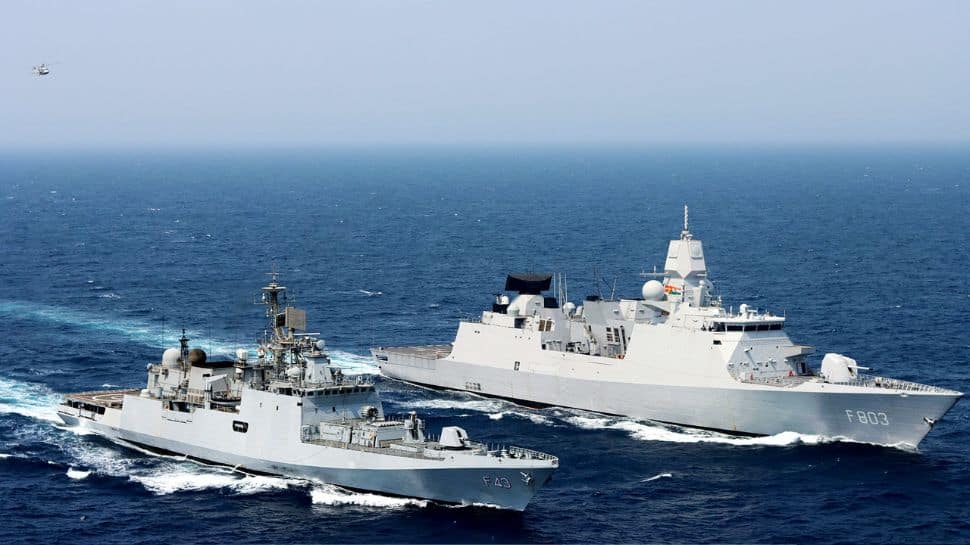India has launched its largest-ever military exercise along the Pakistan border, a massive and unprecedented war game that has deeply unsettled Pakistan’s military leadership. Scheduled from October 30 to November 10, this extensive drill spans a staggering 1,000-kilometer stretch, covering diverse terrains from the coastal marshlands of Sir Creek to the desert sands of Jaisalmer. Unlike previous exercises, this war game marks the first time that India’s Army, Air Force, and Navy will operate as a unified strike force under a single command structure, signaling a significant evolution in India’s military strategy.
The scale and scope of this exercise are truly staggering. India has issued a Notice to Airmen (NOTAM) reserving airspace up to 28,000 feet, nearly the altitude at which commercial aircraft typically fly. This move indicates that the exercise is not merely a routine drill but a sophisticated preparation for full-scale air superiority operations. Defense analysts around the world have described the scale as “unprecedented,” while Pakistan views it as a nightmare scenario that threatens to upend the delicate military balance in the region.
India’s exercise is testing cutting-edge weapons and tactics that could reshape modern warfare. Key components include counter-drone systems capable of detecting and destroying enemy UAVs mid-flight, jamming technologies designed to disrupt Pakistan’s communication networks, and spectrum monitoring tools that track every radio signal crossing the border. These advanced electronic warfare capabilities will be complemented by precision airstrikes executed by Rafale fighter jets and layered air defense systems incorporating Akash and S-400 missile platforms. This combination creates a formidable war machine prepared to dominate from the skies to the sea and across the desert terrain.
Defense experts like Damian Symon have expressed astonishment at the breadth of this operation. The reservation of such a vast airspace corridor indicates that India is preparing not only for defensive maneuvers but also for offensive long-range missile tests and deep-strike capabilities that could reach targets anywhere within Pakistan. The exercise, named “Trishul,” showcases India’s growing confidence in integrated tri-service operations and highlights a strategic shift toward joint command structures to enhance operational effectiveness.
Pakistan’s response has been swift but constrained. Islamabad scrambled to issue its own NOTAM restricting airspace over parts of its central and southern regions on October 28-29, signaling heightened alertness. However, Pakistan faces a grim strategic dilemma. The country is already stretched thin, battling multiple internal conflicts and insurgencies. The Tehrik-i-Taliban Pakistan (TTP) controls checkpoints in the Khyber Pakhtunkhwa province, while the Balochistan Liberation Army (BLA) continues to foment unrest in Balochistan. Moreover, tensions along the Afghanistan-Pakistan Durand Line remain volatile following recent clashes.
This multifront pressure means Pakistan cannot easily redeploy troops to its western border to counter India’s massive exercise without risking internal collapse. If it diverts forces to counter India, insurgent groups gain ground domestically. If it holds its internal lines, India gains a strategic advantage along the border. This puts Pakistan in a precarious position, effectively trapped in a checkmate scenario before the military exercise even begins.
Adding to Pakistan’s strategic challenges are candid assessments from international security experts. Former CIA officer John Kiriakou, who spent 15 years running anti-terror operations in Pakistan, has delivered a stark assessment: Pakistan cannot win a conventional war against India. He has also made controversial claims regarding Pakistan’s nuclear arsenal and its historical ties to terrorism, including allegations that former President Pervez Musharraf sold nuclear secrets to the United States and that Osama bin Laden evaded capture by fleeing into Pakistan disguised in a burqa.
Against this backdrop, India’s leadership has sent clear and direct messages to Pakistan. Defense Minister Rajnath Singh visited both Kutch and Jaisalmer — two critical regions along the border — within a span of 21 days, warning Pakistan that any miscalculation could lead to changes in “history and geography.” This is a pointed reminder of India’s willingness to act decisively if provoked. Similarly, Indian Army Chief General Upendra Dwivedi hinted at “Operation Sindoor 2.0” during the Diwali festival, suggesting that the military is prepared for an intensified campaign along the western border.
The timing and geography of the exercise reinforce this message. The war game covers the exact regions where recent tensions have flared, symbolizing India’s readiness to

